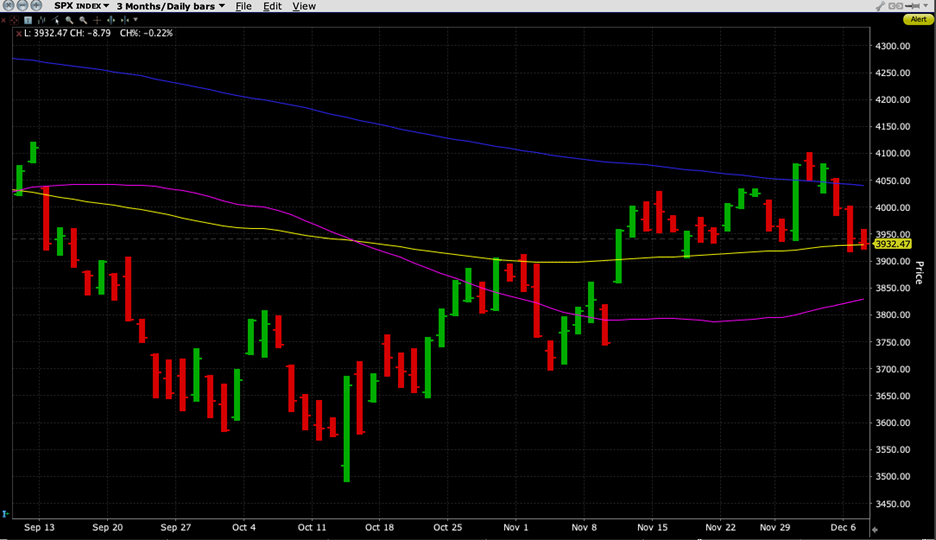A lot of cars have modes. Drivers can select winter mode, economy mode or others based on preferences and road conditions. I assert that equity markets have modes too, based on preferences for fear versus greed and monetary conditions. Risk-on and risk-off are two of the most common modes, but others occasionally come into favor. Yesterday it seemed as though traders switched from “Year End Rally” mode to “Recession” mode. We can thank some of our largest commercial bankers, many of whom told a fairly downbeat tale at a conference, for the most recent malaise.
The stock market actually did a fairly admirable job of staying out of recession mode for as long as it did, because the bond market has been in that mode for quite some time. The inversion between 2-year and 10-year Treasury yields is a rather stunning 82 basis points. To put that in perspective, this is a far steeper inversion than we saw in either 2000 (about 20bp) or 2007 (about 50bp). No, as with so many other economic measures, we need to return to the early 1980s – 1981 in this case – to find a steeper inversion. The message being sent by the bond market is that rates still have room to rise in the short-term but will then decline significantly sometime over the coming years. While some part of the relatively depressed level of long-term yields may not strictly represent fears about a disastrous economy, but instead a continued faith that the Fed will eventually revert to its highly accommodative ways, the economic message is ominous.
So what changed over the past few days? Traders themselves deserve a fair amount of blame. Last week, immediately after the stellar rally that ensued from Chair Powell’s well-received speech at the Brookings Institution, we noted that the enthusiasm may have stemmed more from selective listening than the actual message of the speech. Equities seemed to have switched to “Sanguine Mode” as VIX plunged and there was increasing talk about the seeming inevitability of a year-end rally. But despite a couple of rally attempts, even after what should have been a market-unfriendly employment report, equities were never able to sustain levels above the post-Brookings highs. Perhaps last Wednesday was “Blowoff Top Mode.”
We might be able to blame some of the recent performance on a “buy the rumor / sell the news” scenario involving the loosening of Covid lockdowns in China. This should be helpful for the global economy, but key commodities – notably oil – failed to reflect the enthusiasm. I believe that the easing conditions were already being priced into a wide range of stocks and commodities. Looking at HXC, the NASDAQ Golden Dragon China Index, we see a rally of over 40% over the past month (albeit only to levels last seen earlier this autumn). It is not unreasonable to think that much of that was based upon the reopening trade.
HXC, 1-Year Daily Bars


Source: Interactive Brokers
Yet the recession motif came to the fore yesterday. Leaders of some of the largest US banks spoke at a Goldman Sachs banking conference. None appeared to be particularly upbeat about economic prospects, but Bank of America’s (BAC) Brian Moynihan was perhaps the most glum. He joined the parade of bankers announcing staff reductions, if not outright layoffs, amidst inflationary pressures.
Faithful readers will know that I don’t love the fact that major banks kick-off quarterly earnings seasons. I’ve written how their inputs and outputs – such as trading profits – are highly idiosyncratic yet too many pundits try to extrapolate trends about corporate earnings overall from them. The only real information for the broader economy is gleaned from comments that the banks’ executives may make about their customers’ activities. We were treated, better or worse, to a more detailed preview of those comments at yesterday’s conference, and we didn’t like what we heard.
Even if stocks seemed to switch to “Recession Mode” yesterday, they are hardly in dire straits at the moment. It was notable that we gave back all our post-Brookings gains yesterday, but again, that rally seemed overdone at the time. Both yesterday and today, the S&P 500 Index (SPX) seems to have found support at its 100-day moving average. There was much made about SPX breaking through its 200-day moving average last week, but it provided neither significant resistance nor support. The 100-day, however, has offered both in recent weeks – more recently on the supportive side.
Sharp-eyed readers might also notice that both the 50 and 100-day moving averages are now sloping upward (a first, not second derivative change). Technically that means we could be in a market that is trending higher – though the 200-day disagrees. It is too early to say that we have fully switched stock market modes. Much will depend upon whether the moving averages provide lasting support, and whether market technicals can outweigh a mode shift in the market’s transmission.
SPX, 3 Month Daily Bars, with 50-Day (purple), 100-Day (yellow) and 200-Day (blue) Moving Averages


Source: Interactive Brokers
Disclosure: Interactive Brokers
The analysis in this material is provided for information only and is not and should not be construed as an offer to sell or the solicitation of an offer to buy any security. To the extent that this material discusses general market activity, industry or sector trends or other broad-based economic or political conditions, it should not be construed as research or investment advice. To the extent that it includes references to specific securities, commodities, currencies, or other instruments, those references do not constitute a recommendation by IBKR to buy, sell or hold such investments. This material does not and is not intended to take into account the particular financial conditions, investment objectives or requirements of individual customers. Before acting on this material, you should consider whether it is suitable for your particular circumstances and, as necessary, seek professional advice.
The views and opinions expressed herein are those of the author and do not necessarily reflect the views of Interactive Brokers, its affiliates, or its employees.


























